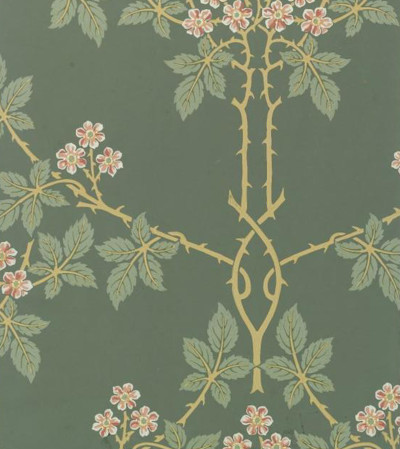William Morris was a master of floral patterns and his designs could be used in all manner of different mediums. This depiction is based on the blackberry plant and is listed in some quarters as being pattern #388. By documenting his different patterns, we can distinguish between the artist and his company's many designs.
This wallpaper design is relatively subtle and calm by his normal standards. Much of the background shows through, making this piece less busy. In other examples he would fill pretty much the entire foreground with an elaborate mix of natural flourishes, with stems and branches curving around each other. He would also incorporate different sizes of flower heads in orer to add variety but in this piece he keeps a single size of flower head. There is also a reduced palette, with green being the dominant tone, both in the foreground and background. This gives a more subtle finish as they is not the heavier contrast found in some of his other paintings. The flower petals are relatively small, with tones of pink and white which add brightness but without altering the balance of the composition. Morris also delivers the prickly points typical of the blackberry plant but does so in a way that feels friendly rather than menacing. As a simpler design, it may have been easier to take this pattern into production as typically there would be amendments once the company started to move into printed fabric or wallpaper. Certain details might not quite come out as intended.
Morris would have found blackberry bushes within his local environment as they are common within the UK. He liked to gain inspiration from natural elements that could be found locally, such as plants, flowers and even flowing rivers. Although his style was influenced by ideas from abroad, his content was very much based on a British slant. The artworks remind many of the beauty of the English countryside, as well as private gardens, and this charming look continues to be popular today for those trapped in large urban areas. The calling of nature is now as strong as it ever has been, and Morris' rejection of mass production also feels entirely appropriate a good century later. He was a true artist, seeking quality and respect over monetary gain and was always interested in reviving or protecting the more traditional methods of production. He is rightly regarded today as one of the most famous and influential British artists of all time, and highly regarded for his ability to work across so many different mediums, far beyond just the blackberry wallpaper pattern found here.
Morris would take on many different flowers and plants during his career, and many of these would hold symbolic values to his work, whilst others were chosen purely for aesthetic purposes. The combination of natural elements within his work and also the traditional methods that he used brought about a high level of integrity to his career and he became highly regarded by the many patrons taken on by his company. Despite avoiding mass production techniques he was still able to achieve profitability, aiming the output of his company at wealthy individuals who could pay a little extra for something that was unique. As his reputation soared, so more patrons would be keen to have his name within their own homes, be it with furnishing fabrics, ceramics, wallpaper or any other products that they produced at that time.




